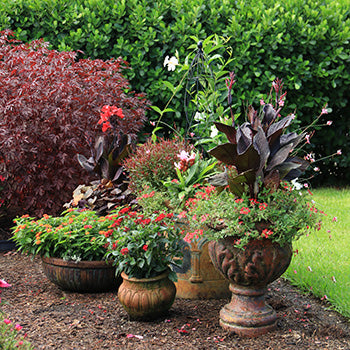By Doug Jimerson
Fall is the ideal time to get back into the garden. It's time to prune, plant, and mulch! Here are some other ideas to get your garden ready for winter.
Put Leaves to Work
Autumn’s cooling temperatures gives you a garden bonus. As leaves fall from the trees rake them up and use them in your compost pile. Or, use them to mulch newly planted trees, shrubs, and perennials. On your lawn, use a mulching mower to break the leaves into tiny pieces that will fall between the grass blades and nourish the soil.

Remove or Replace Annuals
In the North, remove annual flowers after the first frost blackens their foliage. Place spent plants on your compost pile (unless they've suffered disease; it's best to throw diseased plants in the trash so you don't risk spreading the disease into your compost).
In warmer-winter regions, replace summer blooming annuals with cool-season varieties such as pansy and snapdragon to keep the color show going through the winter.
Get cool-season container gardens for winter or early-spring color!

Prune Perennials
>Once your perennial flowers die back and go dormant, prune them back to the ground (or a few inches tall if you want the stem stubs to remind you of their placement next spring). However, you can leave those with interesting seed heads (ornamental grasses, black-eyed Susan, coneflower) alone to provide interest in the winter garden. The seed heads will also provide a welcome treat for songbirds during the winter. Just remember to clip the plants back in the early spring before new growth starts to emerge.
Protect Young Trees
Mice, rabbits, and voles love to dine on the bark of young trees during the winter. To protect your investment, wrap saplings with chicken wire or a plastic tree guard. Plastic tree guards will also protect your tree from sun scald which is characterized by sunken, cracked, or dried bark on the southwest side of your tree. Sun scald happens on cold, clear days during the winter when the sun stimulates the growth cells on one side of the tree which then die as soon as the sun disappears and the temperatures plummet.

Bring on the Bulbs
Once nightly temperatures stay below 50F it’s time to begin planting spring-flowering bulbs such as daffodils, tulips, and crocus. These easy-care flowers pop up in the early spring and add tons of color to beds, borders, and planters. Plant larger bulbs 8 inches deep and smaller ones 4 inches deep. For best effect, plant bulbs in large drifts or clumps. Avoid planting them single file like toy soldiers. In the South, tender bulbs such as crinum, spider lily, and amaryllis belladonna can be planted now, too.
Tune Up Your Turf
As fall progresses, avoid mowing your lawn too closely. Turf grasses need to build up strength to get through the winter so raise your mower blade to a height of 3 inches. Autumn is also a good time to feed your lawn because it helps cool-season grasses such as rye, bluegrass, and fescue green up quickly in the spring. Southern grasses also benefit from a fall feeding.
Move Houseplants
If you put your houseplants outside for a summer vacation, bring them back indoors before frost threatens. Keep in mind that houseplants are tropical in nature and won’t tolerate temperatures that drop below freezing. Hose your plants off to remove dirt, dust, and hitchhiking insects before bringing them back inside.
Get more tips for saving tropical plants for winter.

Add Mums and Asters
Quick color! That’s what you’ll get when you add perennial chrysanthemums and asters to your garden. These fall-blooming beauties tolerate cool temperatures and come in a wide assortment of colors and bloom types. Their nectar-rich flowers will also attract bees, butterflies, and other pollinators to your garden. To insure success with chrysanthemums, plant hardy varieties. Mums sold in florist shops are designed for indoor performance only.

Clean Vegetable Beds
Prevent vegetable pests and diseases from getting a foothold in your vegetable garden by completely removing dead and dying foliage and fruit. Tomato diseases, for example, can overwinter on stems, rotting fruit, and dead foliage so clear away all traces of your crop after the plants finish up for the season. It’s also smart to clean tomato cages and stakes with a dilute solution of bleach. And don’t forget to rake the garden clear of any leftover plant debris

Plan for Fall Color
Get a jump on autumn color by adding fall-blooming perennials to your garden. Often available ready-to-bloom, top late summer and fall flowers include Joe pye weed, Japanese anemone, turtlehead, Russian sage, sedum, hybrid goldenrod, and helenium. Many of these hardy perennials will come back year after year, growing bigger and better with each season.
Dig into our fall design ideas for container gardens and garden beds!
Check out our tips for getting your garden ready for winter!
















